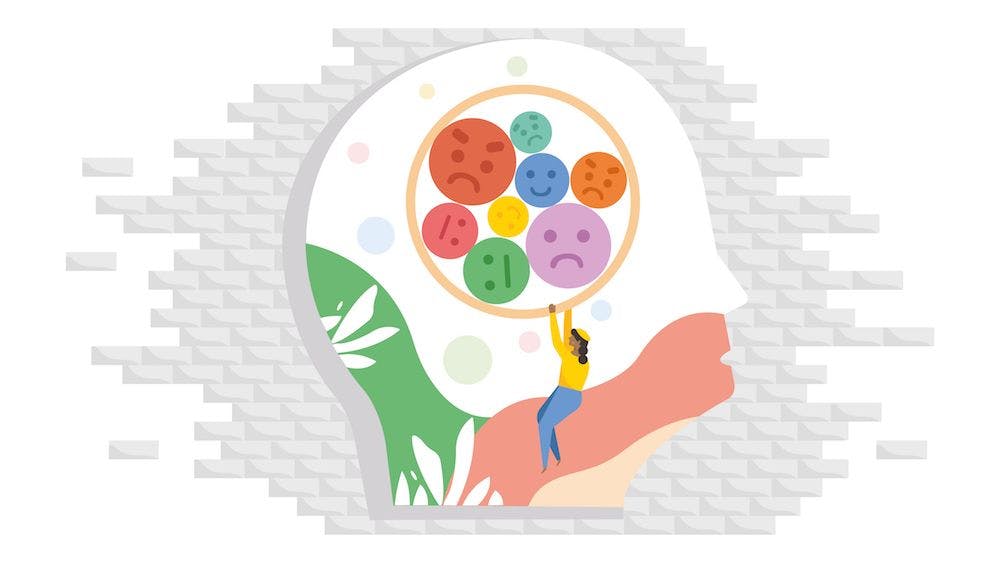
You’ve almost certainly heard of it, but how much do you actually know about bipolar disorder? To set the record straight, Eleanor Segall, who is diagnosed with bipolar one herself, explains the condition, and what you need to know to better support and understand others
Bipolar disorder (formerly known as manic depression) is a chronic mood disorder, where moods oscillate between “high” manic states, normal functioning, and “low” depressive states, often for months at a time. Those with bipolar can take mood stabilising medicines, along with antidepressants to keep these moods more balanced. Many people with bipolar can live fulfilled and happy lives, despite the trauma that episodes can bring.
According to the charity Bipolar UK, between 1% and 2% of the population experience a lifetime prevalence of bipolar, and recent research suggests as many as 5% of us are on the bipolar spectrum.
In 2004, aged just 16, I was diagnosed with bipolar affective one disorder – the most serious type of the illness. It’s a condition that runs in my family, but it can be managed with medication and therapy, as well as having a good support network. Here, I’ll share the things that you need to know about bipolar disorder:
1. There are different types of bipolar disorder
Bipolar disorder happens across a spectrum. Those who have bipolar one disorder will have more severe manic states, potentially leading to psychosis (hallucinations or delusions). Those with bipolar two disorder will have lesser manic states, known as hypomania, and also more mixed states where depression and mania override. However because the manic episodes aren’t often severe enough to warrant hospitalisation, bipolar two is often misdiagnosed as depression.
Additionally, there is a mood disorder called cyclothymia, which is similar to bipolar two, but where the low and high mood swings aren’t as severe or long-lasting as full depressive or manic episodes.
2. The illness often starts in adolescence
Doctors and psychologists aren’t sure why bipolar symptoms appear in adolescence, but believe that the changing hormones during puberty could spark the changing mood states, especially if mental illness runs in someone’s family.
Research suggests as many as 5% of us are on the bipolar spectrum
3. Manic episodes and depressive episodes often have a set of symptoms
Depending on the type of bipolar disorder you have, you may get some, or all, of the following symptoms. Some people rapid cycle, meaning that they have regular changing episodes. For others, separate manic or depressive episodes last for months on end, and people may have to be medicated to improve their state of mind.
Symptoms of mania include:
• Feelings of euphoria, and grandiose thoughts (thinking you can do or be anything)
• Increased speed of speech and
energy levels
• Decreased sleep
• Delusions and psychosis (losing touch with reality). Some people also have hallucinations or hear voices
• Appetite changes
• Aggression and irritability
• Impulsive behaviour (doing things out of character, e.g. spending more, sexual promiscuity, risk taking, or drug and alcohol abuse)
Symptoms of depression include:
• Feelings of hopelessness, leading
to thoughts of death, suicide, or
self-harm
• Changes in sleep (too much or too little, or not being able to get out
of bed)
• Loss of interest in friends and activities
• Feelings of worthlessness, low
self-esteem
• Inability to go to work
• Inability to concentrate
• Changes in appetite
4. There are different causes of bipolar disorder
While the exact cause of bipolar is unclear, some studies suggest bipolar may be genetic. It’s believed that if you have bipolar, there is a 10% chance it can be passed on to your child.
Another accepted theory is that those with bipolar disorder have faulty brain chemistry due to serotonin changes – too much serotonin could cause manic states, and too little, depressive – however, further research is needed. Others suggest that bipolar disorder can be environmental – the result of trauma, abuse, or a difficult upbringing.
5. There are many treatments for bipolar
If you suspect that a loved one has bipolar disorder and is not at crisis point, the first port of call would be their GP. They can get you an urgent referral to a psychiatry team where they will be assessed. For children under 18, this would be the Child and Adolescent Mental Health Services (CAMHS), and for adults, a general psychiatry team.
Treatments include taking medication to control the mood states – mood stabilising medications, and potentially antipsychotic medications.
Antidepressants or anti-anxiety medications may also be discussed.
Other non-medicinal treatments include counselling, such as talking therapies, cognitive behavioural therapy, mindfulness, meditation, exercise, or art therapy.
6. Having bipolar is not a curse – it can boost creativity
Yes, bipolar can be life limiting at times, but there is so much to live for too. Once treatment has taken hold, those with it can go on to live happy and fulfilled lives. But remember that support networks are so important – visit bipolaruk.org for information, find local support groups, and join an online community to support with your diagnosis.
Bipolar is also said to boost creativity – many famous people including Stephen Fry, Demi Lovato, Mariah Carey, and Britney Spears have the condition, and have extremely successful careers. Remember, having bipolar disorder is not the end.
Eleanor Segall is a freelance journalist and mental health blogger with bipolar one disorder. Find out more at beurownlight.com

